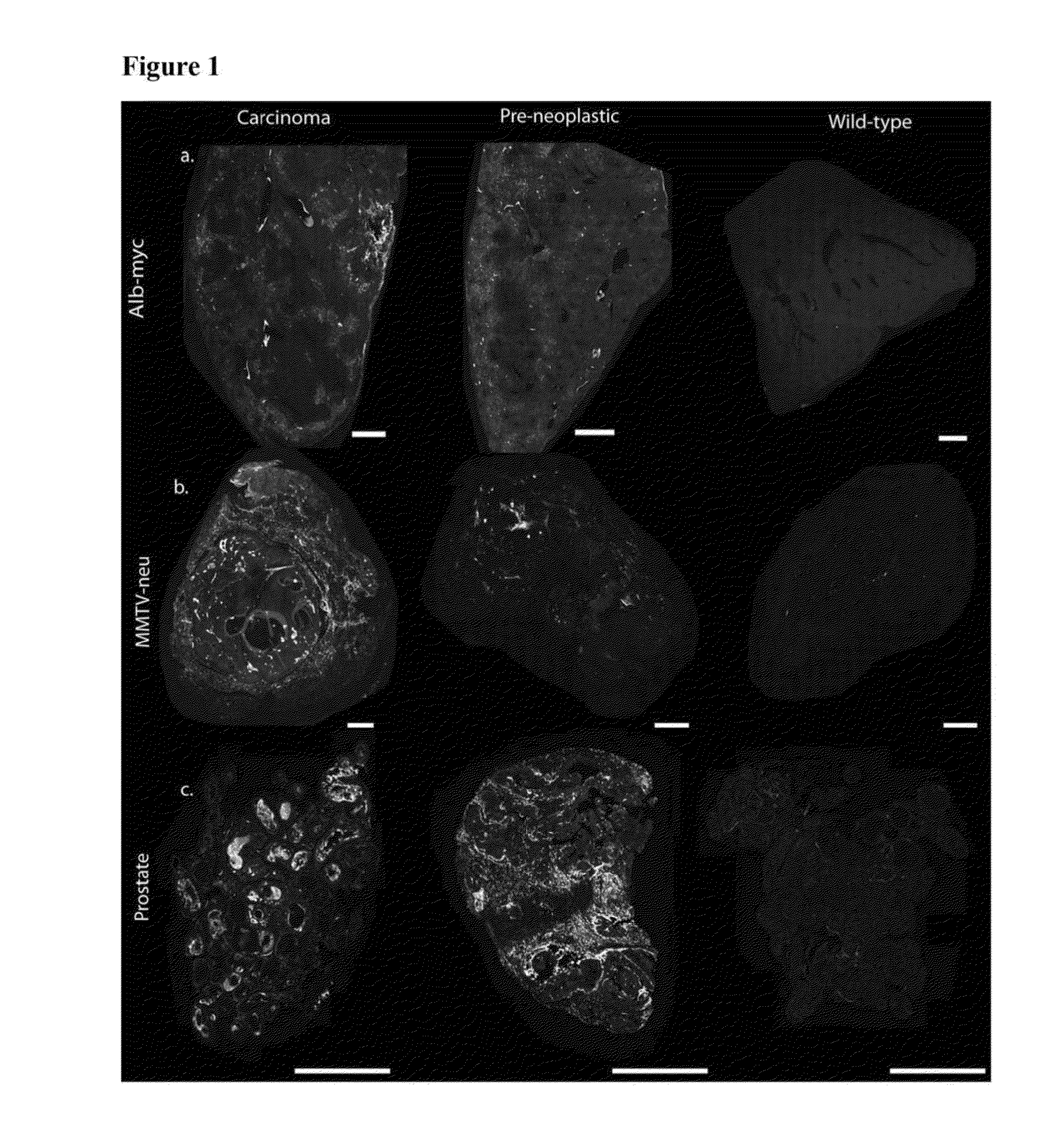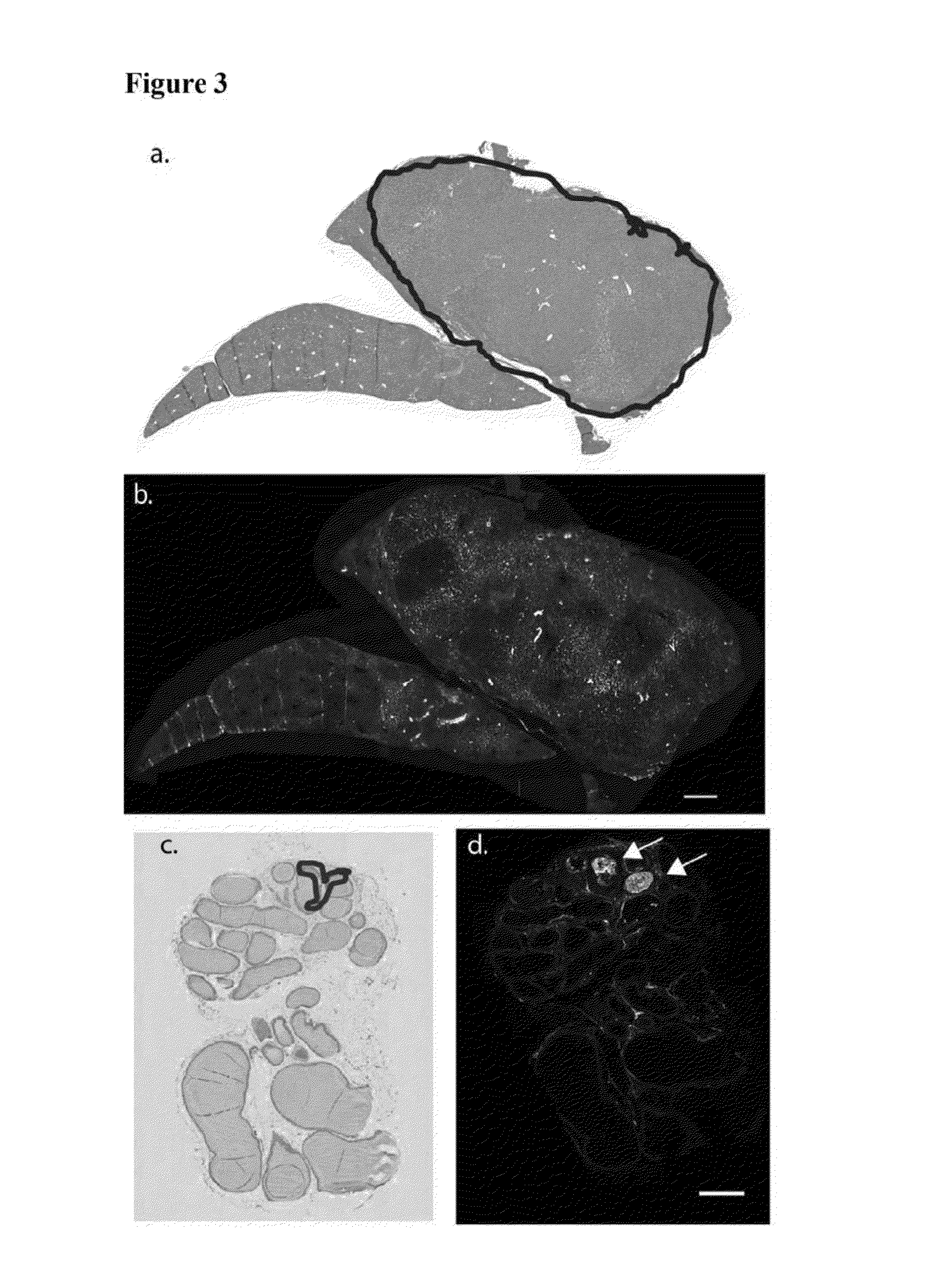Methods of detecting and treating cancers using autoantibodies
a cancer and autoantibody technology, applied in the field of autoantibody detection and treatment of cancer, can solve the problems of neoplasia escaping detection and treatment, complicated diagnosis and therapy, and insufficient diagnosis of many tumor types
- Summary
- Abstract
- Description
- Claims
- Application Information
AI Technical Summary
Benefits of technology
Problems solved by technology
Method used
Image
Examples
example 1
Materials and Methods
[0163]1. Mouse Models:
[0164]The Alb-c-myc mouse models (Murakami et al., 1993) were a generous gift from Herman Stellar and both prostate models (Pb-_ENREF—23MYC (Ellwood-Yen et al., 2003) in FBV background and conditional Pten knockout (Pb-Cre X Ptenf / f) in C57 / B6 background (Trotman et al., 2003a, b)) were a generous gift from Charles Sawyers. Alb-myc and prostate sample controls were C57BL / 6J mice purchased from The Jackson Laboratory. All FVB / N-Tg(MMTVneu)202Mul / J mice, and the corresponding control FVB / NJ mice were purchased from The Jackson Laboratory. In addition six week old BALB / c mice (Jackson Labs) and CBySmn.CB17-Prkdcscid / J mice (Jackson Labs) were injected with a 4T1 cell line. One-hundred thousand cells were injected into a single mammary fat pad of each mouse, and mice were euthanized 14 days after injection. All experiments were approved by the Institutional Animal Care and Use Committee at The Rockefeller University.
[0165]2. Preparation of Tiss...
example 2
Alb-myc Model: Differentiating Abnormal Vs. Normal Tissue
[0179]MYC oncogene overexpression is frequently seen in patients with hepatocellular carcinoma (Shachaf et al., 2004). Therefore, the presence of autoantibodies in an alb-myc mouse model of cancer was probed.
[0180]Liver tissue samples from this tumor model (Murakami et al., 1993) and from wild-type (“WT”) mice were paraffin embedded, mounted on the same slide, and probed with fluorescently tagged horse anti-mouse IgG antibody. In the alb-myc mice, anti-mouse IgG recognized autoantibodies throughout the tissue. Fluorescence was speckled with some areas considerably brighter than others. The anti-mouse IgG associated fluorescent intensity was approximately 50-fold higher in all liver tissue from alb-myc mice relative to tissue from WT mice (1.68±0.366 log 10-fold greater, pa, 2a).
[0181]Similar results were observed with goat anti-mouse IgG. In contrast, there was no difference observed between alb-myc and WT tissue when probed w...
example 3
MMTV-neu Model: Differentiating Abnormal Vs. Normal Tissue
[0185]Human breast tumors contain amplification of HER-2 / neu in 25-30% of patients (Slamon et al., 1989). Thus, the presence of endogenous antibodies in mammary tissue from virgin and multiparous mice expressing the un-activated neu oncogene, driven by a mouse mammary tumor virus (MMTV) promoter was probed (Guy et al., 1992).
[0186]Breast tissue was paraffin embedded and probed with fluorescently labeled anti-mouse IgG; adjacent sections were stained with H&E (n=10 MMTV-neu / WT pairs, 1-2 mammary glands taken from each mouse). Regions were histopathologically graded as either 0 (normal), 1 (hyperplasia without atypia / physiological hyperplasia), 2 (hyperplasia with atypia), or 3 (carcinoma). In the eighteen MMTV-neu tissue samples, six had grade 3 lesions, four had grade 2 lesions, and the remaining samples were grade 0. In the eighteen WT samples, five had grade 2 lesions, eleven had grade 1 regions, and two samples were unifor...
PUM
| Property | Measurement | Unit |
|---|---|---|
| concentrations | aaaaa | aaaaa |
| temperature | aaaaa | aaaaa |
| exposure time | aaaaa | aaaaa |
Abstract
Description
Claims
Application Information
 Login to View More
Login to View More - R&D
- Intellectual Property
- Life Sciences
- Materials
- Tech Scout
- Unparalleled Data Quality
- Higher Quality Content
- 60% Fewer Hallucinations
Browse by: Latest US Patents, China's latest patents, Technical Efficacy Thesaurus, Application Domain, Technology Topic, Popular Technical Reports.
© 2025 PatSnap. All rights reserved.Legal|Privacy policy|Modern Slavery Act Transparency Statement|Sitemap|About US| Contact US: help@patsnap.com



